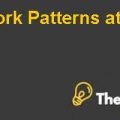Question No. 1
(a)
As mentioned, the investor is using the S&P 500 futures to hedge the risk that his portfolio faces from presidential elections. It is important to use the price index as it is in the form of weighted average, i.e. a normalized average of the price relative to a particular place and the particular underlying asset.
(b)
Basis risk is the risk that a trader faces while hedging his position against any derivatives. In this case, the derivative used is future contract. The risk here is that the future price determine initially may not move with the underlying asset’s price.
(c)
The optimal hedge ratio formula is optimal in a sense that the position taken minimizes the overall variance of the portfolio the most.
Following are its assumptions.
- The total wealth of the investor is invested in the cash position.
- Deterministic production.
Financial Derivatives Assignment Harvard Case Solution & Analysis
Question No. 2
At the end of third year, the company X defaults. The immediate loss is calculated as follows.
Payment due to receive = 2%*20000000
Payment due to receive = 4000000
Payment to Pay = 0.58%*20000000
Payment to pay = 116000
There is no immediate loss to the financial institution. Remaining is 284000.
The remaining swap is valued assuming that forward rates are realized at 0.58% per annum for all the transactions. The floating payment would be the same, i.e. 116000 and the net payment would be 284000.
Discounting these costs at the spot continuous rate, we can obtain the cost of default.
3rd Year = 284000
4th Year = 284000
5th Year = 284000, the cost of default is 847787.3.
Question No. 3
(a)
This question is related to put-call parity. In order to make an arbitrage profit, it is important to trade put at a higher price and trade call at a lower price as to make an arbitrage profit, it is important to buy cheap (call) and sell expensive (put).
(b)
Data
Current Stock Price: 27 CHF
Strike Price of Call & Put Option: 30 CHF
Call Option: 2 CHF
Put Option: 4 CHF
Contract Size: 1
Risk Free Rate: 0.5%
Solution
p = c - S + K*exp (-r*T);
p = 2 – 27 + 30 * exp (-0.5%*1)
p = 4.85 CHF, is greater than 4.
c = p + S - K*exp (-r*T)
c = 4 + 27 – 30 * exp (-0.5%*1)
c = 1.14 CHF, is less than 2.
There is no arbitrage profit for these amounts for the investor.
Question No. 4
(a)
As mentioned in the question, the strike price of both the call and the put options is the same, i.e. 85 and the forward price is 90. Thus, call option is more expensive as its IV (Sf > K; 90 > 85) is positive and that of put option is zero.
(b)
The total amount used to enter the trade of the straddle option is 15. Thus, this is the maximum possible loss if the stock price remains the same at the expiration of the contract..............
This is just a sample partical work. Please place the order on the website to get your own originally done case solution.











